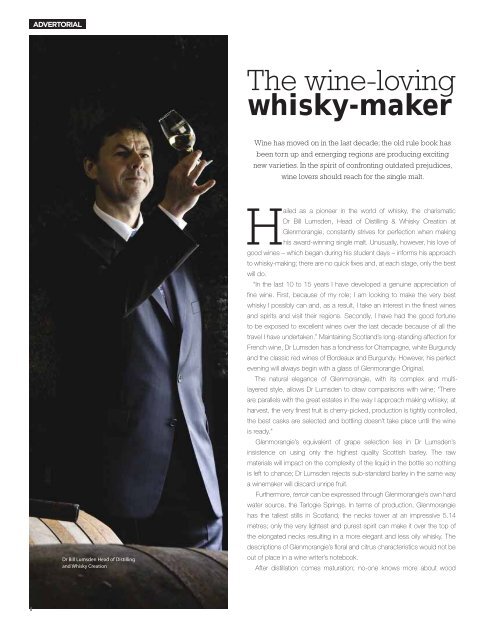Create successful ePaper yourself
Turn your PDF publications into a flip-book with our unique Google optimized e-Paper software.
Dr Bill Lumsden Head of Distilling<br />
and Whisky Creation<br />
The wine-loving<br />
whisky-maker<br />
Wine has moved on in the last decade; the old rule book has<br />
been torn up and emerging regions are producing exciting<br />
new varieties. In the spirit of confronting outdated prejudices,<br />
wine lovers should reach for the single malt.<br />
Hailed as a pioneer in the world of whisky, the charismatic<br />
Dr Bill Lumsden, Head of Distilling & Whisky Creation at<br />
Glenmorangie, constantly strives for perfection when making<br />
his award-winning single malt. Unusually, however, his love of<br />
good wines – which began during his student days – informs his approach<br />
to whisky-making; there are no quick fixes and, at each stage, only the best<br />
will do.<br />
“In the last 10 to 15 years I have developed a genuine appreciation of<br />
fine wine. First, because of my role; I am looking to make the very best<br />
whisky I possibly can and, as a result, I take an interest in the finest wines<br />
and spirits and visit their regions. Secondly, I have had the good fortune<br />
to be exposed to excellent wines over the last decade because of all the<br />
travel I have undertaken.” Maintaining Scotland’s long-standing affection for<br />
French wine, Dr Lumsden has a fondness for Champagne, white Burgundy<br />
and the classic red wines of Bordeaux and Burgundy. However, his perfect<br />
evening will always begin with a glass of Glenmorangie Original.<br />
The natural elegance of Glenmorangie, with its complex and multilayered<br />
style, allows Dr Lumsden to draw comparisons with wine; “There<br />
are parallels with the great estates in the way I approach making whisky; at<br />
harvest, the very finest fruit is cherry-picked, production is tightly controlled,<br />
the best casks are selected and bottling doesn’t take place until the wine<br />
is ready.”<br />
Glenmorangie’s equivalent of grape selection lies in Dr Lumsden’s<br />
insistence on using only the highest quality Scottish barley. The raw<br />
materials will impact on the complexity of the liquid in the bottle so nothing<br />
is left to chance; Dr Lumsden rejects sub-standard barley in the same way<br />
a winemaker will discard unripe fruit.<br />
Furthermore, terroir can be expressed through Glenmorangie’s own hard<br />
water source, the Tarlogie Springs. In terms of production, Glenmorangie<br />
has the tallest stills in Scotland, the necks tower at an impressive 5.14<br />
metres; only the very lightest and purest spirit can make it over the top of<br />
the elongated necks resulting in a more elegant and less oily whisky. The<br />
descriptions of Glenmorangie’s floral and citrus characteristics would not be<br />
out of place in a wine writer’s notebook.<br />
After distillation comes maturation; no-one knows more about wood












